Cauliflower, Brassica oleracea var. botrytis, is a cool-season cruciferous crop that can be challenging to grow.
Many different varieties are available in shades of green, orange, purple, and white.
White types need to have their heads sheltered in order to produce a crop with a snowy color and sweet flavor, in a process known as blanching.
This isn’t the same thing as the practice of par-boiling veggies by dunking them in boiling water before plunging them into an ice bath that you’re probably familiar with.
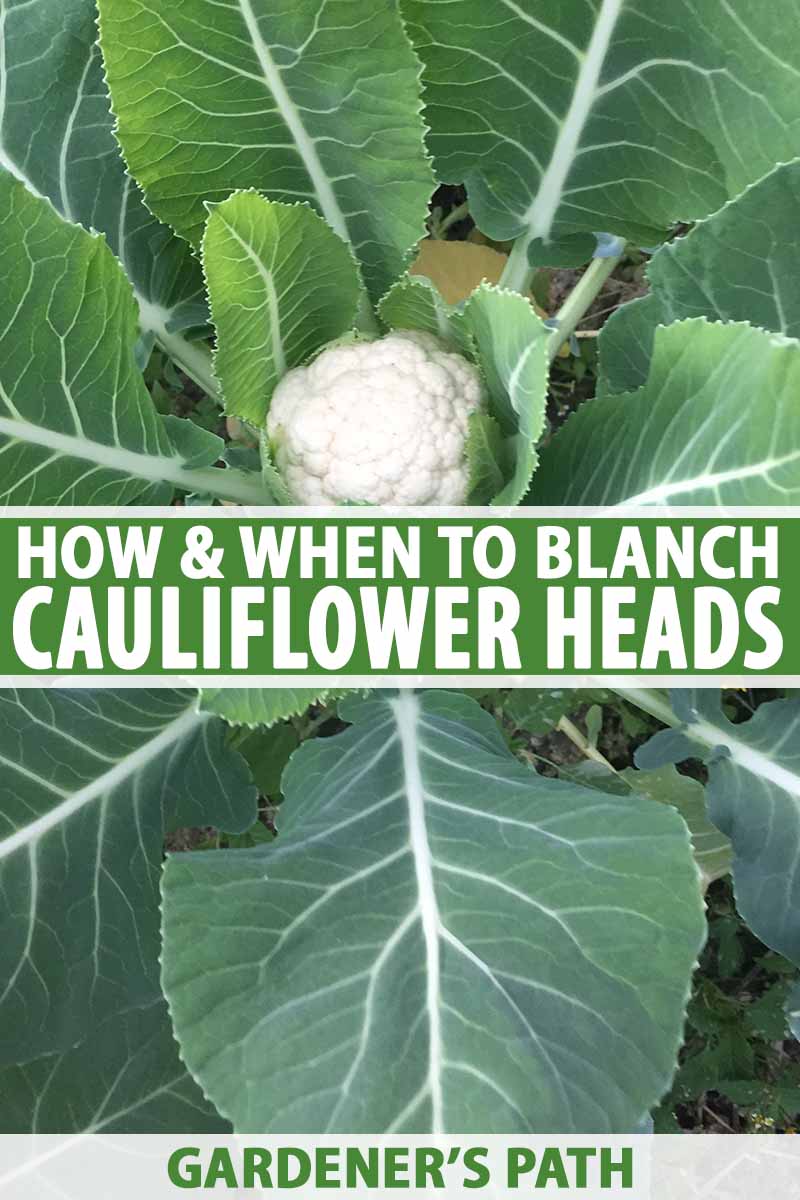
We link to vendors to help you find relevant products. If you buy from one of our links, we may earn a commission.
Blanching is the simple practice of binding large outer leaves together over and around developing cauliflower heads, to prevent them from yellowing or browning and developing a bitter flavor due to an overabundance of sun exposure. Some older white varieties can even turn shades of blotchy purple.
In this brief article, you will learn when and how to blanch cauliflower with its own leaves.
How to Blanch Cauliflower in the Garden
When the Time Is Right
About a month after sowing, healthy cauliflower plants will be lush with leafy foliage. At this time, the first tiny heads should begin to appear. Check our our cauliflower growing guide if you are just getting started.
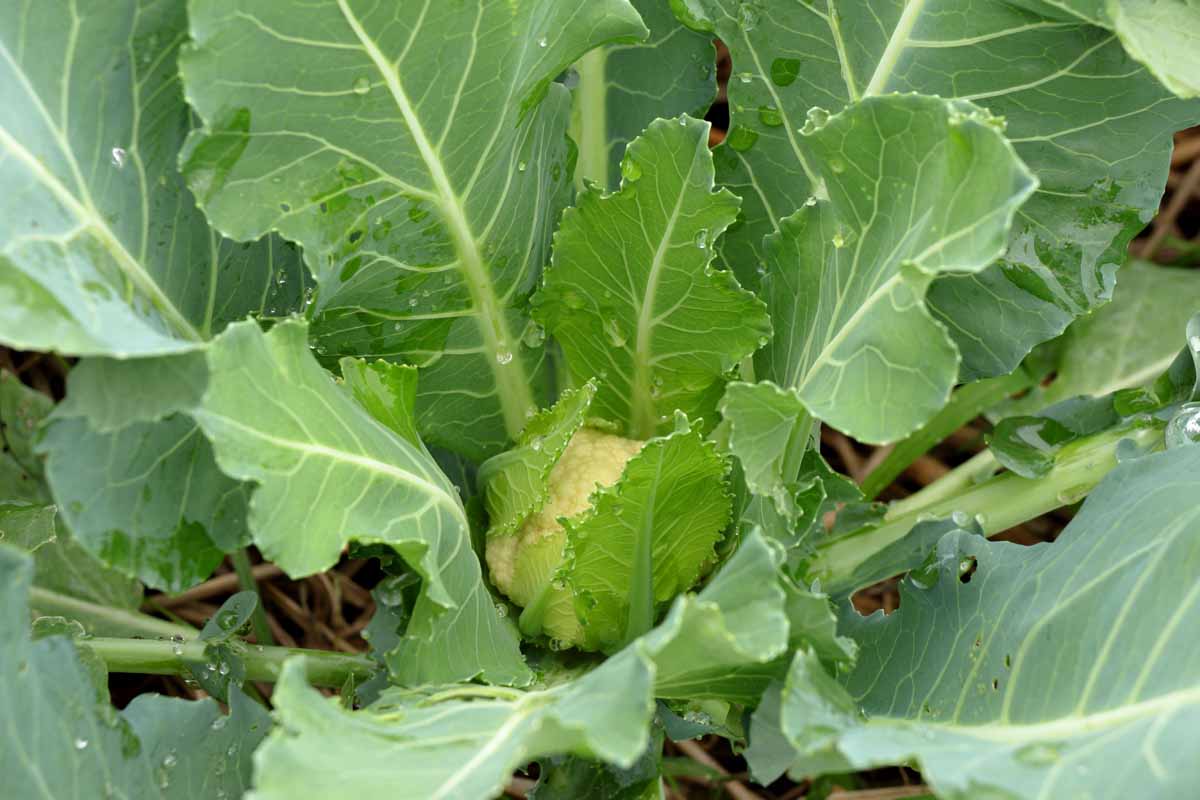
Some cultivars, like ‘Early White Hybrid,’ have foliage that grows upward and outward, away from the heads. This does little, if anything, to shade the developing heads from the sun.
These varieties require blanching by hand to protect them from damage.
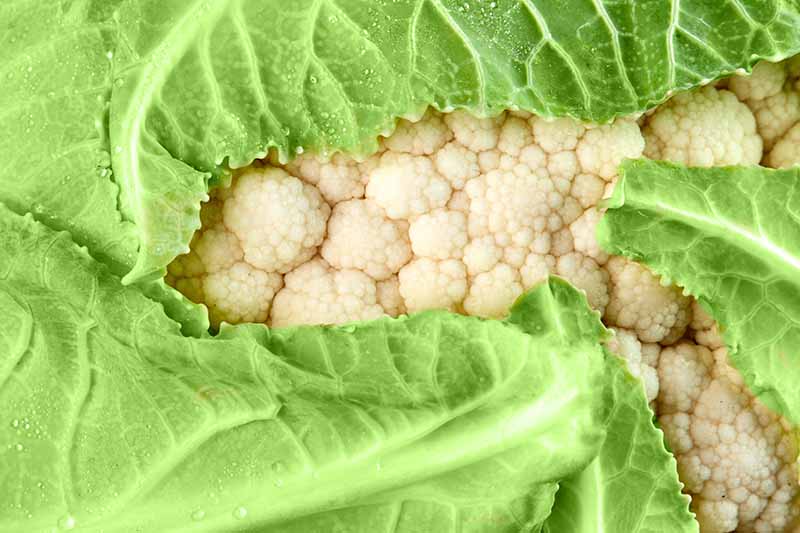
Others, such as ‘Snowball Self-Blanching,’ will naturally wrap their inner leaves around the maturing heads.
Often this is enough to successfully shelter them from the intense rays, but they, too, can benefit from gardener intervention.
It may seem like a no-brainer to buy the self-shielding type.
However, considerations such as flavor, head size, length of the growing season, and price may make other types more appealing to some gardeners.
Watch plants closely when seedlings reach the one-month mark, because you should begin sun protection on a dry day before the heads are 3 inches across, for the most appetizing crop.
If you start late, or skip blanching altogether, you are likely to still produce an edible crop. However, the curds may be discolored or even sun-scorched, and the flavor may become bitter.
How to Go About It
If you’re not sure whether you have a self-blanching variety or not, look at how the leaves are growing. If they are wrapping around the developing head and effectively shielding it from the sun, you may not need to take any protective action.
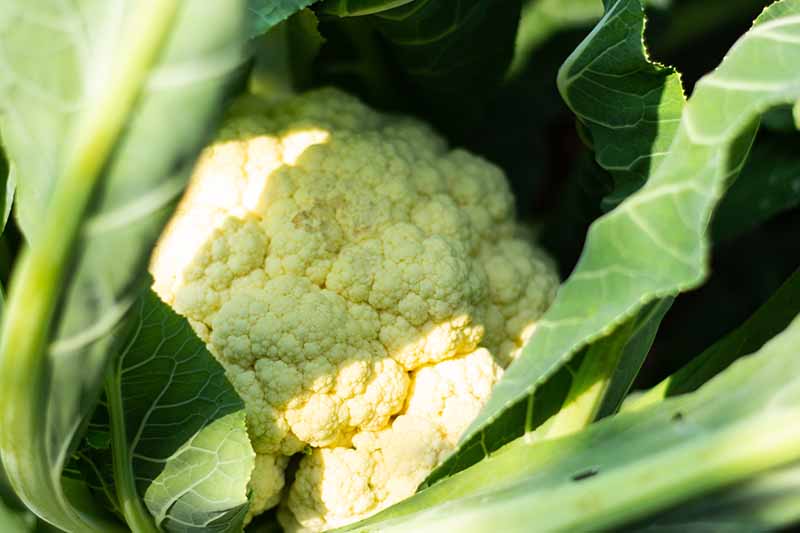
However, if the leaves are growing up and away from the head, this could leave your crops vulnerable to the sun’s rays. In this case, you’ll need to take steps to make the leaves cover the heads.
Here’s how to do it. It’s very easy. Imagine peeling a banana in reverse.
- Choose a large leaf with which to begin.
- Gently bend the leaf inward over the center of the plant. Hold the leaf in place.
- Grasp a second leaf in the same fashion, and fold it over to meet the first, over the center of the plant. Hold the tops of both leaves together in one hand.
- Use your other hand to gently bend a third leaf inward to meet the first two. Grasp all three leaves together in one hand, over the center of the plant.
- If necessary, bend a fourth leaf inward to meet the other three, to effectively hide the developing head.
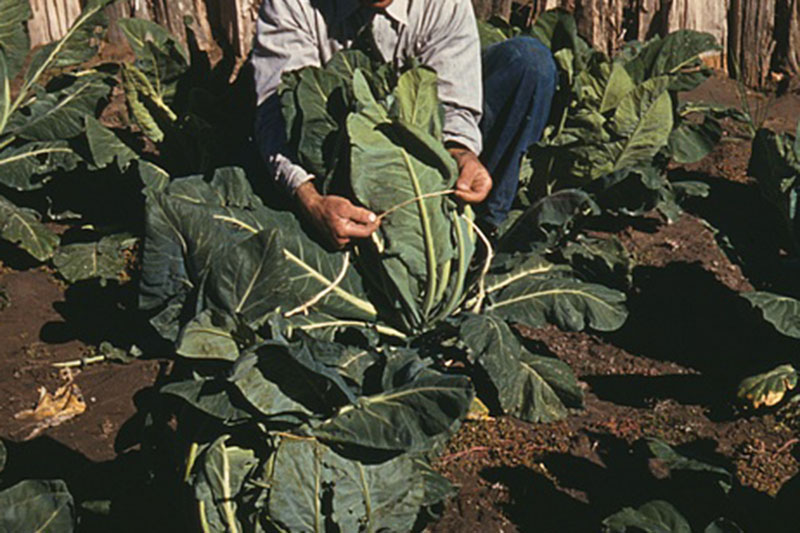
- Use twine, rubber bands, or clothes pins to loosely bind the leaves you are grasping together. Secure them either at the top or around the middle, so they go over and around the head, completely covering it.
Imagine peeling a banana in reverse again. We have to make the open peels stay closed.
However, we also need to leave some room for airflow, for peeking in to monitor progress, and to allow the head to reach its mature dimensions of six to eight inches in diameter. This is why we bind them loosely.
Alternative methods include bending large leaves over the head until they touch the ground, and weighing them down with a brick or rock, or placing a large container over entire plants.
I’m not a fan of these methods, for two reasons:
First, they can reduce airflow and lead to fungal growth.
And second, by enclosing the ground, it can create a moist space that’s attractive to nibbling slugs and snails.
Here’s a tip: Blanch on a dry day, after the morning dew has evaporated. This way, no moisture gets trapped near the curds and fungal growth is inhibited.
That’s all there is to it!
Harvest Ready
Check developing heads every few days by peeking in between the leaves. Keep an eye out for any hidden pests, and treat as needed. Learn more about controlling cauliflower pests here.
In one to three weeks, they should reach their mature dimensions and be ready for harvest. When the time is right, simply unbind the leaves to reveal your crop.
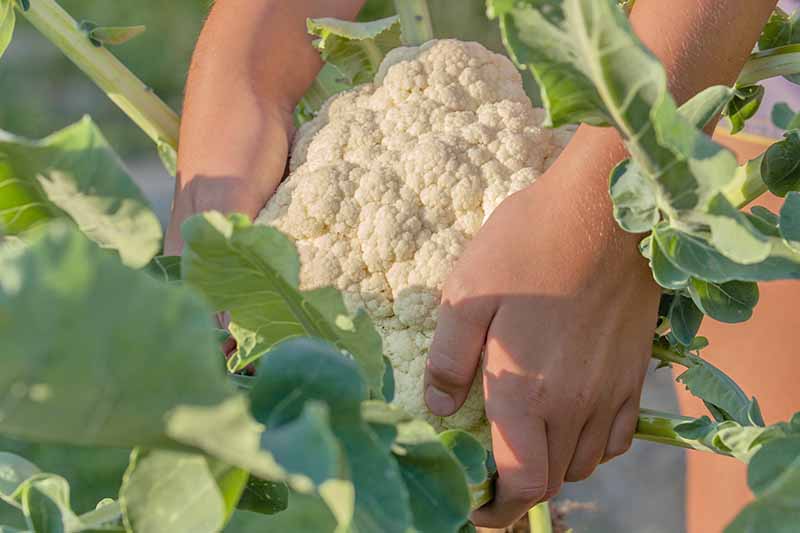
In addition, if your self-blanching varieties do not seem to have enough foliar coverage, or if you are experiencing a heatwave, don’t hesitate to gather and bind their outer leaves to prevent the heads from discoloring.
Read more about harvesting cauliflower here.
Crisp and White for Your Cooking Delight
Blanching to preserve color and flavor by creating a shelter of foliage is an easy technique that you can use with confidence. Two other vegetables that are often blanched to lighten their color and sweeten their flavor are asparagus and celery.
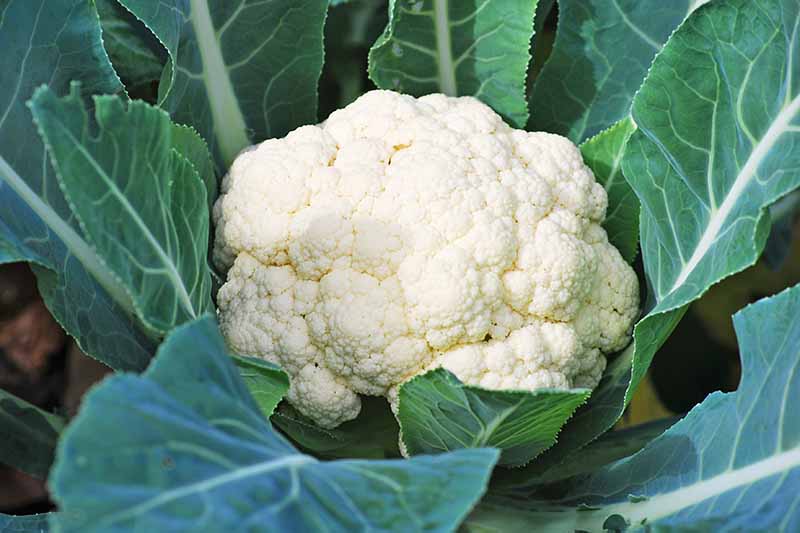
Add cauliflower to this year’s garden planner, and get ready to reap the rewards of a challenging crop well cultivated!
And be sure to visit our sister site, Foodal, for tasty and nutritious cauliflower recipes.
We love hearing from our readers. Do you have any advice for cauliflower growers? Have you tried blanching your crops in previous years? Please share your stories in the comments section below, and don’t forget to tell us what zone you’re growing in!
Learn more about growing cauliflower with these useful guides: :
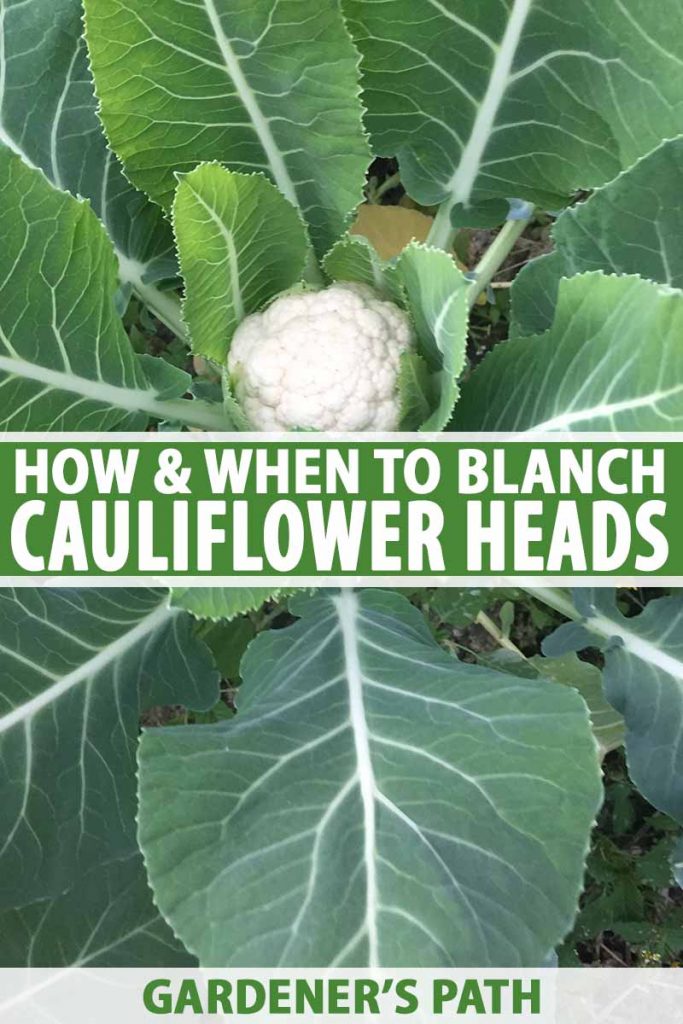
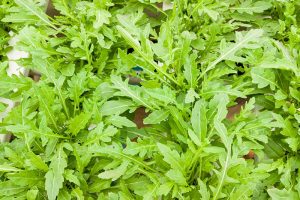


Hi, really enjoy your growing expertise on vegetable growing. This is my first attempt at gardening. I’m in Canada. I’m trying cauliflower for the first time. Following your advice on the process. Recently read an article on a tapeworm very prevalent in this vegetable that is to tiny to see but is very harmful if eaten in the cauliflower which now is making me question about eating cauliflower which I love raw. Any comments on this and is it true.
Thank You so much for you opinion.
Hi Sheila – We’re glad you found the article informative. Great question. Cysticerosis is a parasitic infection transmitted by the larva or egg form of the pork tapeworm, Taenia solium. It is prevalent where sanitation and hygiene are poor, pigs come into contact with human feces and roam among crops, and meat is undercooked. Hygienic practices like handwashing, and the washing of vegetables before consumption, go a long way toward minimizing the risks of contracting foodborne illness. In addition, growing veggies at home, instead of buying products from unknown sources that have been handled multiple times, also minimizes the risk… Read more »
We blanched this year and they turned out awesome. We never had it work before this year. And the taste was to die for.
That’s great, Connie! Thanks for sharing.
We live in St. George, UT. We planted cauliflower seeds in late September and we now have heads showing. A few weeks ago, I blanched the first few and I think I did it too soon. The little buds grew long thick stocks and poked their heads out beyond the leaves. From what I’ve read, the heads should be at least 3″ across before doing that. Is there any way to salvage the ones that have grown out? Glad I found your site. If you can give me any advice that would be great. Take care.
Hello Rich –
Cauliflower is such a temperamental crop! Blanching a little too soon may not be the culprit here. Our article, “11 Reasons Why Your Cauliflower May Not form Heads” may help guide you as you assess the situation. And unless the plant bolts, or runs to seed, you may still be able to salvage sweet, tender florets.
Hi, I didn’t know the heads were to be covered, I do now, lol. The heads of cauliflower are about 4″ is it too late to cover them?
Hi Murray –
It’s not too late to cover the developing heads to protect them from direct sunlight. Good luck with your crop!